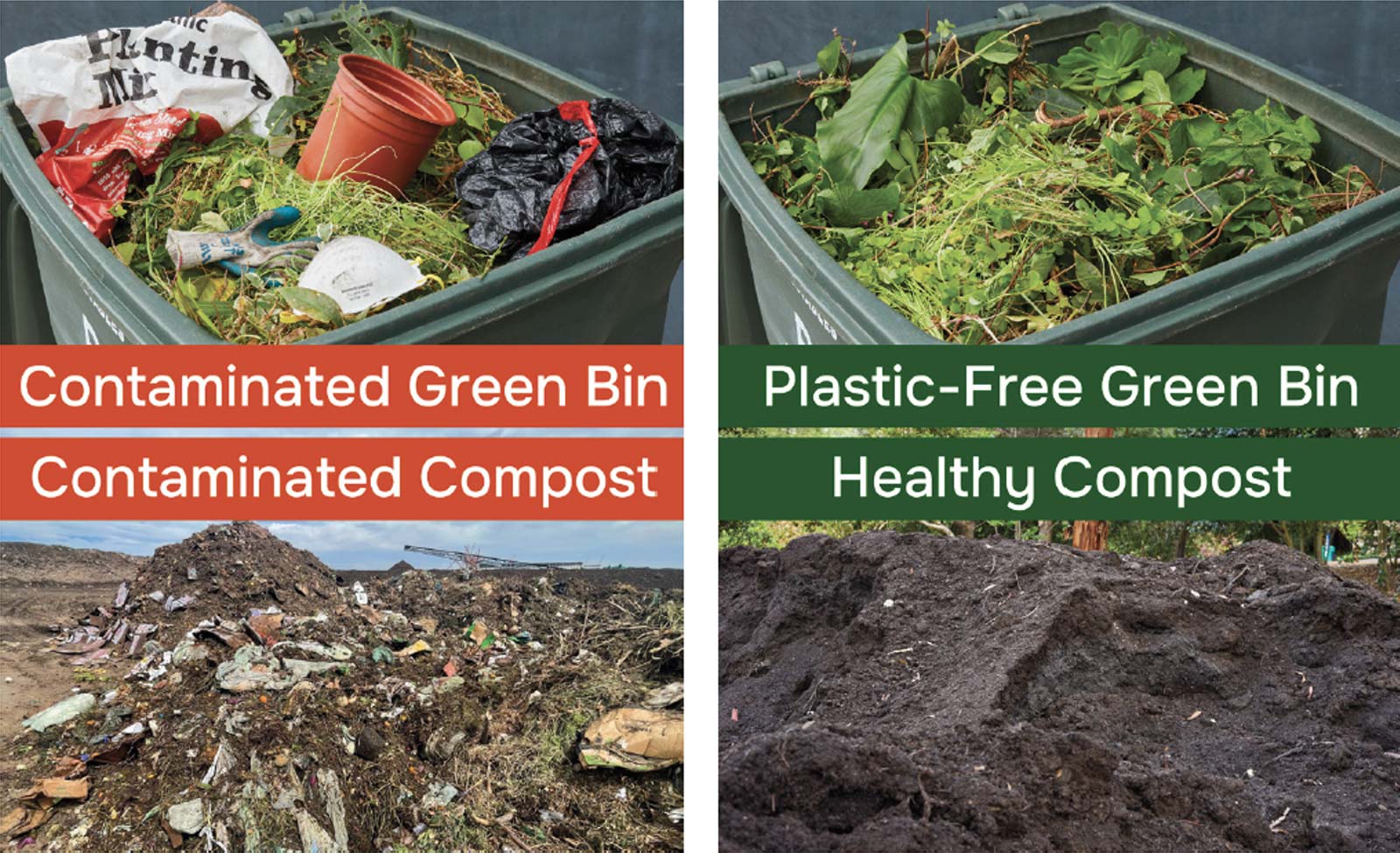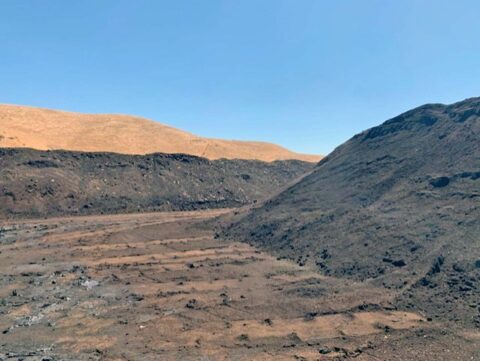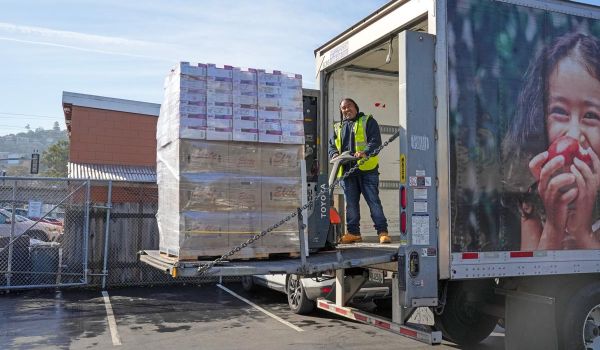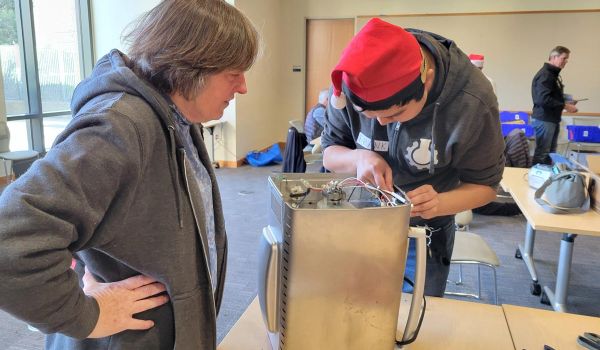We’re Making Compost — Let’s Make it Healthy!
By admin
Keep All Plastic Out of the Green Bin
Everyone in San Mateo County is required to compost all food scraps and yard trimmings. It takes a little extra effort, but the results are worth it! If we all do our part, we’ll have a greener, healthier community with more beautiful outdoor spaces and nutritious, local fruits and vegetables for everyone to enjoy. Yes, there’s a direct benefit: Your food scraps and yard trimmings are turned into nutrient-rich compost that’s used locally in San Mateo County.
If you’ve already been composting, that’s great, please keep it up! This is also a reminder to keep all plastics out of the compost bin, including those little stickers on fruit and the twisty ties on vegetables and herbs. For a list of what can and can’t go into the green bin, visit healthycompost.org.
Why we are composting
San Mateo County is composting because it brings many benefits to our community.
It’s the law and makes landfills last longer
It’s costly to site and build new landfills once the old ones are filled up. By keeping food waste and yard trimmings out of the landfill, in addition to making useful compost, we can make existing landfills last longer. There’s a statewide law (SB 1383) that requires cities and counties to reduce the amount of organic waste going to the landfill.
Enriches and stabilizes the soil
Compost feeds the grass in our parks and sports fields, helps gardens bloom, and supports farmers in growing healthy crops. Over time, soil loses nutrients and must be replenished. Using natural compost to enrich the soil is a better alternative to chemical fertilizers, which can pollute our water. Compost also helps soil absorb more water, which reduces erosion and water runoff, and helps ease drought conditions.
Fights climate change
When food is thrown into the landfill with other garbage, it decomposes in a way that produces methane, a powerful greenhouse gas that contributes to climate change. Methane is more than 28 times more potent than the carbon dioxide (CO2) emitted from burning fossil fuels. Composting food instead of throwing it into the landfill substantially reduces methane emissions and can make a significant impact on the fight to slow climate change.
What we all need to do: “Food in, plastic out”
Contribute your food scraps and plant and yard trimmings to the community by putting them into the green bin so we can make compost!
- Separate food from all plastic packaging, plastic bags, and plastic containers.
- Remove all labels, ties, and tags from fruits and vegetables before you put them in the green bin.
- Empty collected food scraps directly into the green bin. If you use a bag to collect your food scraps, use a paper bag. If using a plastic bag, empty all the contents from the plastic bag into the green bin, and put the plastic bag in the trash bin.
- Check with your waste and recycling hauler on where to put plastic food packaging (recycling or landfill bin).
For more details, watch the video.
Why it’s important to keep plastics out of the compost
The compost we use for public parks and that local farmers use to grow crops must be free from contaminants. Plastics contaminate the compost. You may have heard of microplastics, which are tiny bits of plastic litter that are in the environment and may pose risks to our health and to nature.
Although composting facilities do their best to remove materials that can’t be composted from the collected food and plant trimmings, not all contaminants, especially small pieces of plastic, can be removed. The sorting machinery can also tear plastic bags and packaging while trying to remove them, resulting in small plastic bits and microplastics in the compost pile. Other small pieces of plastic, like the stickers you find on fruits and vegetables, are also difficult to remove.
We certainly don’t want to add more plastics to the soil. If there are plastics in the compost, farms and ranches can’t use it. So, let’s keep the plastics out and make more, healthy compost!

What is compost, anyway?
Compost is a dark, crumbly, soil-like mixture made up of a combination of carbon-rich materials (“browns”), such as dry leaves and untreated wood chips, and nitrogen-rich materials (“greens”), such as food scraps. Compost is primarily used to enrich or provide nutrients to soil. In addition, because it’s good at absorbing water, compost also is used to prevent soil erosion and reduce the effects of drought.
How does compost get made?
Compost requires microorganisms (bacteria, fungi) to break down the materials that go into making compost. To help the microorganisms do their job most efficiently, composting facilities “pamper” them by providing just the right mix of carbon-rich and nitrogen-rich materials, moisture, warm temperatures, and oxygen.
Composting facilities compost our food scraps and yard trimmings on a commercial scale – it’s an impressive operation!

Yes, composting can be stinky. Here’s what you can do
Collecting food scraps can produce odors you’d rather not smell, especially in the kitchen. The good news is, there are some easy things you can do to reduce the smell factor.
In your kitchen:
- Dump out and clean the compost bin/container in your kitchen often.
- Use a brown paper bag for food scraps and put it in the large green bin each day.
- Freeze smelly items until compost bin pick-up day.
In the curbside green bin:
- Put yard trimmings or newspaper at the bottom of the bin to absorb moisture.
- After trash pick-up, rinse the bin with mild soap and water.
- Set out the compost bin every week, even if it’s not full.
- If your green bin gets really stinky, ask your waste and recycling hauler if they will clean your curbside bin or switch out the ones you have for clean ones.
Happy composting!
Composting community members: your local parks, sports fields, gardens, and farmers thank you! Also, thanks for making the extra effort to keep plastics and other trash out of the green bin so we can make even more healthy compost. For additional information, tips, and a handy poster of what can and can’t go into the compost bin (in English, Spanish, and Chinese), visit healthycompost.org.
We are committed to building a sustainable community that fulfills the needs of the present and future.
Get Involved
Help us build innovative solutions that address today’s changing environment while solving for a sustainable future.



